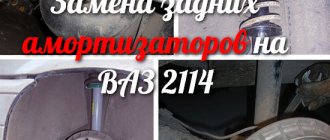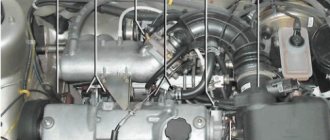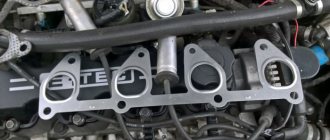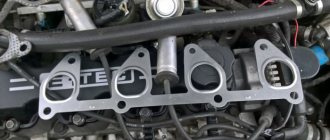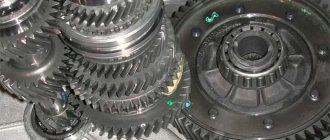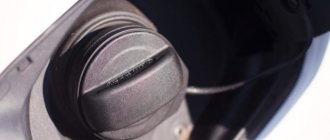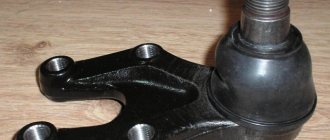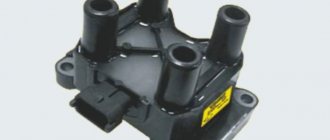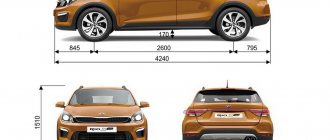| Options | Fuel tank volume, l |
| 1.5 MT Basic | 43 |
| 1.6MT0 | 43 |
| 1.6 MT Basic | 43 |
| 1.6MT0 | 43 |
| 1.6MT0 | 43 |
| 1.6MT2 | 43 |
| 1.6MT0 | 43 |
| 1.6MT0 | 43 |
| 1.6MT2 | 43 |
| 1.6MT0 | 43 |
| 1.6MT1 | 43 |
| 1.6 MT 211440-24 | 43 |
| 1.6 MT 211440-26 | 43 |
Tank volume for VAZ 2114
Dimensions
Chassis
Fuel
Engine
The most common fuel tank sizes in cars are 40, 50, 60 and 70 liters.
Judging by the volume of the tank, you can tell how big the car is. In the case of a 30 liter tank, we are most likely talking about a small car. 50-60 liters is a sign of a strong middle peasant. And 70 indicates a full-size car. The volume of the fuel tank would be a useless quantity if it were not for fuel consumption. Knowing the average fuel consumption, you can easily calculate how many kilometers a full tank of fuel will last you. On-board computers of modern cars are able to quickly show this information to the driver.
The fuel tank volume of the Lada 2114 Samara is 43 liters.
Fuel tank design
The main function of a fuel tank is to store a certain amount of fuel. At the same time, everything must be organized so that the likelihood of a fire hazard is minimized.
On VAZ cars the fuel tank is located under the rear seats. Due to this placement, in the event of serious accidents and car overturns, the tank in most cases remains undamaged. VAZ fuel tanks are made of leaded steel sheets. Thanks to a thin layer of lead that protects against corrosion, the service life of the tank is significantly increased. The outside of the fuel tank is covered with dark enamel.
The fuel tank, covered with dark enamel, is reliably protected from corrosion
The fuel storage volume of the VAZ 2108 and other similar models is 43 liters. This takes into account the reserve, but it is not recommended to fill the tank to the brim. You should always leave a free volume of about four liters. It is especially important to do this in the summer, since the fuel expands as the temperature rises. If the tank is filled to the brim, then after swelling it may simply burst. The volume of the VAZ gas tank is designed in such a way that the autonomous mileage is enough for 500 kilometers, and this is considered a normal road segment in modern conditions.
The tank is securely fixed to the car body using flexible and durable plate-type clamps. Rubber gaskets must be placed under the clamps to ensure a tighter connection.
The tank mounting plates are very flexible and durable
Gasoline is poured through the neck on the right (in the direction of travel) rear side of the body. It is closed with a screw cap.
The neck of the VAZ 2115 tank is closed with a tight lid
Main elements of the fuel tank
The neck is connected to the tank cavity through the filler hose. The other two tubes are integrated with a seven-liter separator installed outside the tank and designed to capture gasoline vapors. As a result of wear, the separator may split along the seam and gasoline will begin to leak out. It can be replaced without dismantling the tank. Moreover, you can temporarily cover the separator seam with a gasoline-resistant sealant.
The separator tank holds seven liters of fuel
In order not to remove the separator (it is necessary to dismantle the bumper and filler pipe), experienced car owners simply disconnect the hoses of the element and cut it out with metal scissors. In place of the separator, a fine fuel injection filter is installed, which performs similar functions.
Instead of a separator, you can install a fine fuel filter
Some separators are equipped with a double-acting valve to minimize fuel leakage. The valve admits and releases gasoline vapor. Once in the tank, the vapors condense and thereby reduce fuel consumption.
The fuel system of the VAZ 2112 car is quite simple
The tank of VAZ cars produced after 2000 is equipped with a fuel level sensor (FLS), which regulates the amount of gasoline in the tank and sends data to the electronic control unit (ECU). The sensor is fixed through a rubber gasket and can be easily removed through the rear seat.
The fuel level sensor is installed on all VAZ models produced after 2000
VAZ 2114 tank volume: finding out the real numbers
Before we look at the main question - how much volume the VAZ 2114 tank holds, let’s look at the main technical characteristics of this car.
Its engine parameters are as follows:
- working volume - 1499 cm3;
- total power - 77 hp;
- maximum rotation speed - 5200 min-1;
- maximum torque - 116 N/m.
In turn, the main operating parameters of the VAZ 2114 car look like:
- acceleration time from 0 to 100 km/h - 14 s;
- maximum possible speed - 157 km/h;
- fuel consumption in urban conditions (per 100 km) - 9.9 l;
- fuel consumption on a suburban highway (per 100 km) - 6.2 l;
- fuel consumption when traveling in mixed conditions (per 100 km) - 7.5 liters.
Now consider the main weight and dimensions of the car:
- total length - 4122 mm;
- full width - 1650 mm;
- height - 1422 mm;
- ground clearance - 165 mm;
- wheelbase size - 2460 mm;
- front track - 1400 mm;
- rear track - 1370 mm;
- weight (curb) - 985 kg;
- weight (total) - 1410 kg;
- fuel tank volume (full) - 43 l.
As you can see from the table above, the gas tank on the VAZ 2114 holds exactly 43 liters. Is this really so? Let’s look at it below.
Consumption and travel distance
If we take into account the volume of the VAZ 2114 tank and the data on gasoline consumption (given in the table above), we can draw the following conclusions about the possible travel range.
When driving at a constant speed of 90 km/h, the maximum range can be almost 700 km without additional refueling.
Fuel system VAZ 2114
When traveling in the so-called “mixed” city/highway mode, consumption will increase, which means the range will decrease (up to 640 km).
And when traveling only in city mode (taking into account standing in traffic jams and a large proportion of driving in low gears), fuel consumption will be maximum - almost 10 l/100 km. It is also worth considering that these figures are for new cars. For used cars they will be slightly higher.
How many liters are in the gas tank of the 2115?
BODY Body type Sedan Number of doors 4 Number of seats 5 Length 4330 mm Width 1970 mm Height 1402 mm Wheelbase 2460 mm Front track 1400 mm Rear track 1370 mm Ground clearance 170 mm Maximum trunk volume 427 l ENGINE Engine location Front, transverse Engine volume 1596 cm3 Power 81 l. With. At rpm 5200 Torque 120/2700 n*m Power system Distributed injection Presence of turbocharging - Gas distribution mechanism - Cylinder arrangement In-line Number of cylinders 4 Number of valves per cylinder 2 Fuel AI-95 TRANSMISSION Drive Front Number of gears (mechanical transmission) 5 SUSPENSION Type front suspension Independent McPherson type Rear suspension type Trailing arm BRAKE SYSTEM Front brakes Disc Rear brakes Drum PERFORMANCE INDICATORS Maximum speed 158 km/h Acceleration time (0-100 km/h) 13.2 s Fuel consumption on the highway 7.6 l/100 km Fuel tank capacity 43 l Vehicle curb weight 985 kg Tire size 165/70 R13; 175/70 R13
Like all VAZs - 43 liters. to capacity!
according to passport 42_5
Today I looked at half the tank
Major damage to the gas tank
When using a fuel tank for a long time, situations arise that require repair. First of all this:
- holes and cracks resulting from mechanical stress and corrosion;
- clogging of pipes and hoses directly connected to the tank;
- damage to the connecting seam at the junction of the tank halves.
Small cracks are usually sealed. This is a rather labor-intensive procedure, but the functionality of the tank can be completely restored. In case of major damage or holes, the tank is replaced with a new one. Dirt gets into the hoses along with low-quality fuel. In this case, the mesh through which gasoline enters the tank may become clogged. Therefore, it must be periodically washed and changed. In addition, you should only refuel at proven gas stations and do not abuse additives to reduce fuel consumption. The weakest point of the tank is the seam, which is constantly subjected to severe stress. This can be avoided if the tank is made in one piece. The fuel tank can also fail due to deformation of the neck, formation of dents after an accident, separation of partitions inside the tank, etc.
How to fill
When the old substance is completely drained, you can proceed to the second part.
- Tighten all plugs.
- Disconnect the hose from the pipe and fill with antifreeze. Fill in the liquid
- Reinstall the hose and add more.
- Tighten the plug.
- Turn on the engine and let the car idle. This will remove all the air.
- Turn off the engine. Check the level and sensor. If everything is in order, then put on the mudguard, tighten the fastening bolts, put the cap on the tank and close the hood.
Done, the replacement in the VAZ 2115 was successfully completed.
Coolant temperature sensor
How often should you change the engine oil: opinions of car owners
- It all depends on the lubricant Tank volume for VAZ 21099
“The brand name is of great importance. Domestic cheap Lukoil is replaced every 5-6 thousand. More expensive oils have many high-quality additives: detergents, anti-aging, anti-foaming, etc. During the first tens of kilometers, the engine is cleaned under the influence of high temperature, the detergent components evaporate, and restorative additives come into play.Such oil should also not be “driven” for more than 10 thousand. The motor will constantly be washed out and, I think, will require “capitalization” faster because the layer formed by the reducing components on the metal surface will constantly be destroyed. I believe that the mileage between replacements should not exceed 10–12 thousand kilometers, and it is advisable to do maintenance after the winter season; in winter, accumulated condensate can negatively affect the properties of the oil.”
- Changing the oil is like brushing your teeth
“There is an opinion (and whether you believe it or not is up to you) that lubricants now are completely different from what they used to be, even from famous brands, and that they are all poured from the same barrel underground somewhere in Poland or Samara. Therefore, you need to change the oil and... the car more often))). Here everyone chooses their own decision. Considering today's fuel prices, replacing lubricant is not that expensive. To please your engine - is this unpleasant for a good owner? Changing your oil is like taking care of your teeth. We clean in the morning and sometimes before bed. More often does not mean better, as we wear away the enamel more; but even less often - it can lead to caries. Setting priorities is up to you personally.” - Looking for a middle ground
“How often to change the oil largely depends on how you use the car. Replacement every 5-7 thousand km is paranoia and a waste of money. The opposite extreme is to drive 500–1000 km every day and forget to change it altogether when the mileage is already under twenty. But it’s better every 10,000 km - this is a good reinsurance for our difficult Russian conditions. For example, new Kia-Sportage models have a service-to-service mileage of 15,000 km. It turns out that 10–12 thousand is the golden mean. Any lubricant - Motul, Castrol, or even our LUKOIL or Lux - will withstand this period perfectly.” - The engine runs even when the odometer does not turn
“On most public pages and auto forums, entire threads of holiwars and battles arise regarding oil changes. Manufacturers often recommend changing it every 10,000 or 15,000 kilometers. The mindset of an ignorant consumer is to follow this recommendation, because otherwise we will lose the warranty. Being under warranty service, as many people believe, means “you came, left the key, and they silently did everything right for you.”However, anyone who has actually encountered dealers knows that the “officials” have a different vision of the guarantee. As an experienced master, I can say that often the lubricant practically loses its properties after 6-7 thousand. And don’t forget that Muscovites, for example, drive their car most of the time in traffic jams, the odometer doesn’t spin, and the engine idles.”
- In any case, it is better to rely on engine recommendations ahead of schedule. It’s better to focus on the standard requirements of automakers regarding intervals and timing of maintenance.”
What is better antifreeze or antifreeze for VAZ
Beginning car owners of the domestic automobile industry, learning the basics of car ownership, often ask various questions about servicing and repairing VAZs.
One of the most frequently asked questions regarding the cooling system: which is better - Antifreeze or antifreeze for VAZ? The question is quite interesting and is asked often, especially from owners who purchased a car, but were unable to get a clear answer from the former owner as to what was poured into the cooling system.
And before the winter period, when car preparation is required, this question comes up and makes you think. Let's try to figure it out.
Installing spacers for front shock absorbers
To begin with, we will look at how to raise the front of a VAZ 2114. But before you start increasing the car’s ground clearance, you should prepare all the necessary tools. So, you will need a set of keys, a hammer, as well as a lift or inspection hole (without them it will not be possible to complete the installation procedure).
The process of installing spacers is carried out in the following order:
- Place the car in the pit.
- Raise the front end using a jack.
- Remove the tie rod pin from the front strut (you may need a hammer and pry bar for this).
After the ground clearance of the front rings has been increased, spacers should also be installed under the rear pillars.
Installation of spacers under the rear shock absorbers is carried out according to the following scheme:
- Unscrew the fasteners of the lower part of the shock absorber.
By carrying out such a simple operation, you can significantly increase the vehicle's ground clearance in just a couple of hours compared to the factory version.
It should also be noted that after the changes have been made, the car should have the following toe-in/camber angles (with a load of 4 adults in the cabin and 40 kg of payload in the trunk):
- camber - 0°±30';
- toe - 0°00'±10' (0±1 mm);
- castor (rotation axis angle) - 1°30'±30'.
Without load, these same values must be within the following limits:
- camber — 0°30'±30';
- toe - 0°15'±10' (1.5±1 mm);
- castor - 0°20'±30'.
If the specified parameters go beyond the above acceptable limits, then you cannot operate the car - you should correct them yourself or at a service station.
Transmission and chassis of the VAZ 21093
The transmission on the VAZ 21093 is structurally made of one unit, including a clutch and a manual gearbox (MT). The gearbox is combined with a differential, the clutch is single-plate. The clutch housing is connected to the flywheel with bolts. To ensure contact with the pressure plate, six elastic plates are used.
The car's wheel drive includes two constant velocity joints (CV joints): a rod shaft on the left and a tubular shaft on the right. The front suspension of the car is independent, hydraulic shock absorbers, cylindrical springs. The rear suspension is torsion bar, independent, with a trailing arm design.
The braking system on the 21093 uses front disc brakes and rear drum brakes. There is a diagonal interaction of contours. One circuit includes the right front and left rear wheels, the other - the remaining two. The hydraulic drive of the system includes a vacuum booster and a pressure regulator for the rear brakes.
The VAZ 2109 was first produced back in 1988. The five-door design allowed this car to be used as a successful family commercial vehicle. At the same time, the car is often used for transporting small-sized cargo, as it is equipped with a fairly simple luggage compartment.
Due to the fact that the VAZ 2109 is a very practical and easy-to-maintain car, it is popular among young people. Due to its distinctive sporty look and great lightness, it is ideal for tuning enthusiasts. Modernization in this area includes not only a transformation of the appearance, but also engine tuning. Sports riding enthusiasts change the following:
- basic bumpers - for stylish sports body kits,
- install powerful, direct-flow exhaust pipes,
- standard air filters - for sports ones.
The car gains improved aerodynamic properties and increased power. But tuning fans don’t stop there and upgrade the engine in a sporty way. Today you can often find VAZ 2109 with turbine engines, which take part in street racing along with foreign cars.
Another way to tune a VAZ 2109 is to replace the car’s dashboard. In configuration, it is similar to panels of such brands as BMW 3, Mazda 626, Opel Vectra. They are so suitable in configuration that they do not undergo any modifications before installation in the “nine”. Anyone who plans to do this will replace the dashboard of any problems.
The VAZ 2109, the price of which is affordable for everyone, has proven itself well on the Russian market. And despite the fact that the production of the “nine” has completely stopped since 2011, it is still in high demand. To make the car more interesting, you will have to spend money, but after tuning it will be difficult to recognize it as a VAZ 2109.
The production of the VAZ-2109 car began in 1988 by the Volzhsky Automobile Plant. Its predecessor was the VAZ-2108, compared to which the body of the “nine” became more elongated, and there were two more doors (five). Thanks to the increased number of doors, many people used it as a family car.
The interior of the VAZ-2109 is strictly practical and claims to be comfortable. In the first case, we should note the laconic “low” dashboard, which is somehow a little convenient. The front seats have headrests. In the second case, it is worth noting the informative “high” dashboard, thanks to which you can clearly monitor the status of its on-board systems.
And thanks to the improved interior (door upholstery with rates, fabric seat upholstery), the car can acquire a more prestigious look. If you fold the rear seats, this car takes on a cargo-passenger appearance, like a station wagon.
The last cosmetic upgrade for this car was made in 1997. Since 2001, they began to produce them with injection engines. Maintenance of this car is almost as economical as for other models of the Volzhsky Automobile Plant.
https://remontvazov.com/obem-baka-vaz-2114https://avtokent74.ru/obem-baka-vaz-2114/https://automanya.ru/lada-drugoe/obem-baka-2114.htmlhttps: //vazlada.info/vaz-2109/benzobak-vaz-2109/https://vazlada.info/vaz-2109/benzobak-vaz-2109/
